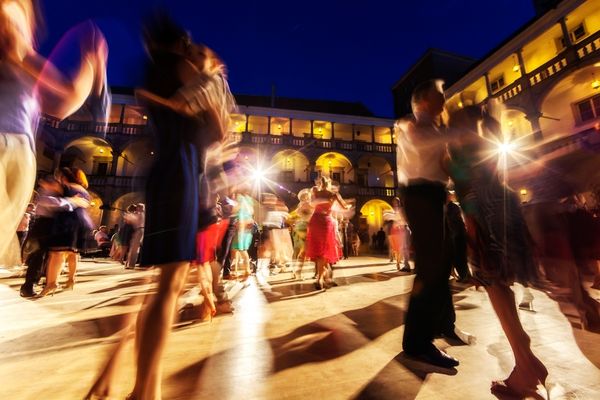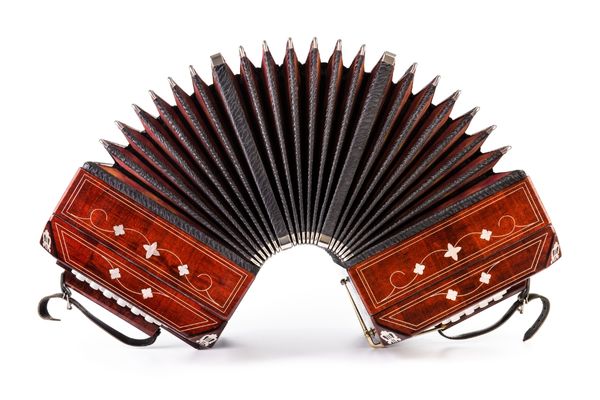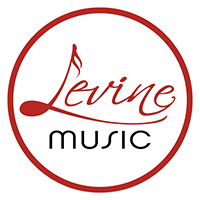A red rose. An enticing rhythm. The mesmerizing swirl of frilled dresses on the dance floor. Tango evokes romance, passion, and energy like perhaps no other style of music. Ahead of our Baroque to Tango Levine Presents performance, here’s a closer look at tango music in all its breathless beauty.
What Is Tango?
Tango is a popular dance and music style that originated in the late 19th Century in Buenos Aires, Argentina. Its roots can be traced back to various cultural influences, including African, European, and Indigenous music traditions. Tango music is characterized by its rhythmic and melodic structure, as well as its use of instruments such as the bandoneon, cajon, violin, and guitar. Read on to find out more about the history of tango, its defining characteristics, and the enduring legacy of this musical style.

The History of Tango
The history of tango music is closely tied to the history of Buenos Aires and its diverse immigrant population. During the late 1800s and early 1900s, Buenos Aires was a melting pot of cultures, with large numbers of immigrants arriving from Europe, Africa, and other parts of South America. Tango music was influenced by these diverse cultural traditions, as well as by the music of the indigenous Mapuche people of Argentina.
Tango music and dance enjoyed a surge in popularity during the early 20th Century, with tango clubs and dance halls popping up all over Buenos Aires. Its popularity spread to other parts of South America and eventually to Europe, where it became a favored dance style in Paris and other cities.
Through the course of time and geographic spread, tango has undergone many changes, with new styles and variations emerging as the genre has evolved. Styles of tango include Argentine tango (also known as traditional tango), ballroom tango, and North American tango. Today, tango in all its forms is popular all over the world, with concerts and festivals dedicated to the genre in many different countries.
Characteristics of Tango
Tango music is typically characterized by a rhythmic structure known as the “tango beat” or “tango rhythm,” which consists of four beats per measure. The melody is typically played over this beat, with the bandoneon playing the lead role. Tango music is also characterized by its use of syncopated rhythms, which give it a sense of rhythmic complexity and energy. Other common characteristics include:
- A 2/4 or 4/4 time signature
- Strong influence of European classical dance music, including minuet, flamenco, polka, mazurka, and contradanza
- Additional influence from Argentine folk music, including the payada and milonga styles, and Uruguayan folk music such as pampas
- Spanish-language lyrics (although instrumental tango music is common)
Tango lyrics often deal with themes of love, loss, and longing, and are usually written in a poetic or metaphorical style. Many tango songs are known for their emotional intensity, and the dance style itself is often associated with passion and romance.
Tango instruments also play a large role in the style of the music. This is particularly true of the bandoneon, a small accordion-like instrument that was popularized in Argentina by German immigrants. The bandoneon is known for its distinctive sound, which is characterized by a deep, rich tone and a strong emphasis on melody. Other instruments traditionally used in tango music include the violin, guitar, piano, drums, double bass, flute, and clarinet.

Famous Tango Musicians and Songs
One of the most famous tango musicians of all time is Carlos Gardel, who was known as the “King of Tango.” Gardel was a singer, composer, and actor who helped to popularize tango music around the world. He was a pioneer of the tango canción, a style that focused on vocal melody and lyrics. Gardel’s style influenced many other tango musicians, and the popularity and compelling power of his music remains undiminished today.
Other famous tango musicians include Astor Piazzolla, who is credited with modernizing tango music and bringing it to a new level of prevalence. Piazzolla was a composer and bandoneon player who fused tango music with jazz, classical, and other styles. His music was innovative and groundbreaking, and he is considered one of the most important figures in the history of tango.
Famous tangos you may know include pieces like:
- La Cumparsita – Gerardo Matos Rodriguez
- Por Una Cabeza – Carlos Gardel
- Libertango – Astor Piazzolla
- Mi Buenos Aires Querido – Carlos Gardel
- Canaro in Paris – Alejandro Scarpino
Today, tango music remains a vibrant and vital part of the music scene and continues to captivate and inspire audiences around the world. If you would like to experience this first-hand, we invite you to our Baroque to Tango performance at Levine, taking place at our DC Campus: NW. La Poesia, a cello quartet made up of Levine faculty members, will explore the relationship of song, dance, and instrumental music with the help of GRAMMY-nominated bandoneon player Heyni Solera and Adas Israel’s famous cantor, Arianne Brown. RSVP for our February 11, 2023 performance here!
At Levine, we offer outstanding music instruction and programs to students of all ages, interests, and skill levels at five campuses in the DC area. At each Levine campus, our students find a diverse range of musical activities, a supportive environment, and dedicated teachers to challenge their creative limits and to guide them. We also offer online learning! Click here to explore our areas of study today!
